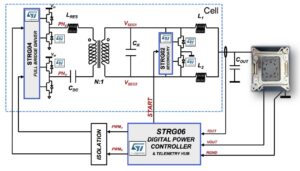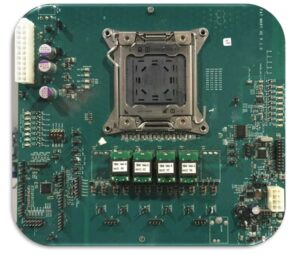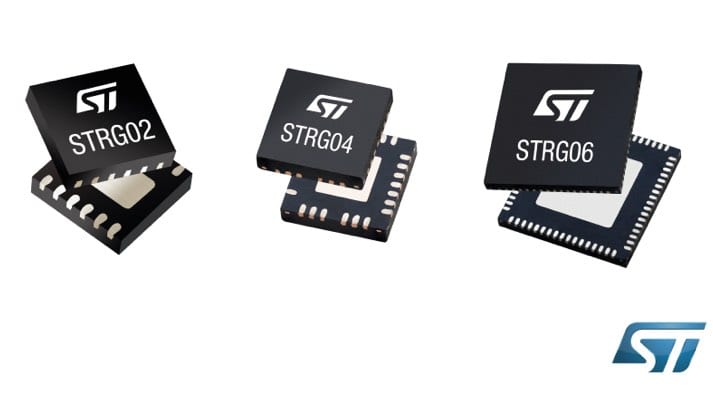As data centers call for motherboards to have a 48 V direct power conversion system, ST offers a turnkey solution with three dedicated ICs, the STRG02, a synchronous rectifier, the STRG04, a high-voltage full bridge driver, and the STRG06, a multi-phase digital controller. The idea of using direct power conversion isn’t new, and it has been popular for decades in telecommunication infrastructure installations. However, when it came to servers, manufacturers chose to adopt an intermediate voltage conversion of 12 V before generating the end load voltage. The reason was mostly financial. 12 V POL (Point-of-Load) converters were more common, and thus cheaper. They also generated less electromagnetic interference noise , which allowed engineers to place them closer to the CPU’s socket to enjoy more board layout flexibility.
48 V Direct Converters for New Realities

However, times are changing and data-center technology drivers, like Google and Intel, are now calling for 48 V motherboards, because they greatly improve efficiency, simplify designs, and reduce heat dissipation. This is becoming increasingly important as processors use more and more cores, and manufacturers rely on the parallelism of a myriad of GPUs. Furthermore, even if Moore’s law isn’t dead, the rate at which process nodes are shrinking has slowed down considerably. For instance, Intel, which used to promise a smaller process node every two years, was forced to change its roadmap to a three-year stretch, and has already warned that the first wave of 10 nm dice won’t be as fast and powerful as the latest 14 nm chips.
Hence, processors can’t easily employ new process nodes to decrease their power consumption anymore. As a result, even a single percentage point increase in the efficiency in generation of the power rails carries huge financial and environmental gains. However, improving the performance of the intermediate voltage converters is now proving almost impossible. Hence, the simplest approach is to move to 48 V direct conversion, and remove the intermediate converters altogether. This is where ST comes in with its years of experience in power supply components, such as its VIPer family of high-voltage converters.
48 V Direct Converters for New Processors

Another challenge that has crept up during the last few years comes from the processors’ newest power management schemes. Intel’s VR13 specification, introduced with its Skylake architecture, demands that the converters be able to dynamically turn on and off the cells used to send the appropriate voltages to the processor, to further reduce power consumption when idle. However, their operating frequency must be high to appropriately respond as the processor load increases. For instance, the last cell is usually dedicated to the chip’s Turbo boost, meaning it will be switched on and off very frequently, as the system adjusts the processor’s clock. Hence, the agility and speed of the power management solution is crucial because a system that doesn’t deliver accurate voltages or respond fast enough can cause serious problems.
ST’s turnkey solution using the STRG02, STRG04, and STRG06 components, is one of the very few that is fully compatible with the VR13 specifications, meaning that motherboard manufacturers know their products are already compatible with the future Xeon Skylake-EP and Skylake-EX chips. To top it off, as ST’s dynamic cell management system relies on a special pulse-skipping technique, the time it takes to operate the system is greatly reduced, with a turn-on/turn-off time of only 20 µs, and the efficiency of the overall operations are further optimized, to reduce power consumption even more.
A Lot Quieter
However, if 48 V direct converters always had the reputation of being more efficient, ST had to come up with a solution for the fact that they tend to be very noisy. That’s why its design uses Zero-Voltage Switching (ZVS) and Zero-Current Switching (ZCS).
Not only does this system improve efficiency by a few percentage points, it reduces noise generation. As a matter of fact, electromagnetic interference is so low that engineers can place converters much closer to the CPU, without any negative impact on performance, which enables more design flexibility. However, the ultimate flexibility comes from the modular aspect of ST’s solution. With this one design, motherboard manufacturers can scale their system by simply adding or removing cells, and a single cell can easily power multiple low-voltage rails used for smaller components.
To know more about ST’s 48 V Direct Power Conversion solution, please visit its website.
